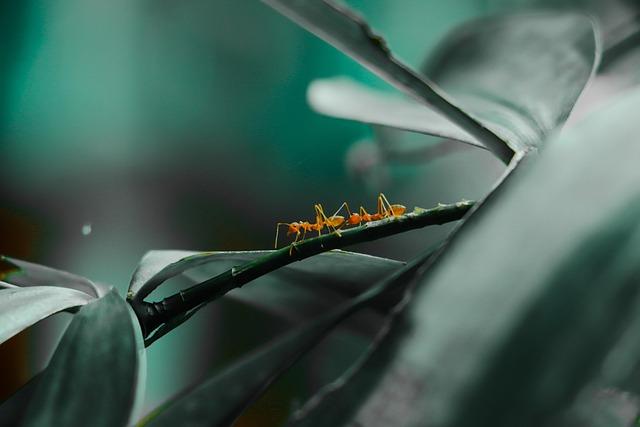A recent study highlighted by EurekAlert! reveals a promising breakthrough in the battle against invasive crazy ants. Researchers have discovered that dismantling the intricate nest structures these ants build significantly compromises their defenses, making them more susceptible to harmful pathogens. This finding could pave the way for innovative pest control strategies targeting one of the most resilient and disruptive ant species worldwide.
Understanding the Vulnerability of Crazy Ant Nests to Pathogenic Attacks
Recent studies have unveiled a critical weakness in the architectural defenses of crazy ant colonies. When the integrity of their nest structure is compromised, these ants become significantly more susceptible to infectious agents that would otherwise have little effect. The nests, typically intricate and densely packed, serve as a formidable barrier against a wide array of pathogens. However, disrupting this environment disrupts the microclimate and social cohesion essential for the colony’s health, exposing the ants to bacterial, fungal, and viral threats that quickly infiltrate weakened defenses.
Researchers highlight several key factors that contribute to this vulnerability:
- Microclimatic changes: Nest destruction alters humidity and temperature, conditions critical for pathogen suppression.
- Social disorganization: Damage reduces coordinated grooming behaviors that ants use to remove pathogens.
- Increased exposure: Opened nest areas allow swift entry of airborne or soilborne microbes.
| Parameter | Intact Nest | Damaged Nest |
|---|---|---|
| Humidity Level | 85% | 45% |
| Temperature Stability | 23°C ± 2°C | 15°C ± 7°C |
| Pathogen Presence | Minimal | High |
| Grooming Frequency | Frequent | Reduced |
Innovative Methods for Disrupting Crazy Ant Nest Integrity
Recent breakthroughs in combating crazy ants focus on undermining the structural integrity of their nests, a tactic that leaves colonies highly susceptible to environmental pathogens. Scientists have engineered biodegradable compounds that, when applied to nests, weaken the ant’s intricate soil architecture without causing immediate colony collapse. This subtle disruption increases moisture retention and alters airflow, creating conditions favorable to fungal and bacterial infections. Researchers emphasize that targeting nest construction behaviors through these innovative methods could revolutionize pest management, offering an eco-friendly alternative to traditional chemical insecticides.
Among the most promising techniques are targeted biofoam applications and microbial inoculations that mimic natural nest-decomposing agents. These methods exploit the ants’ reliance on stable tunnel systems to maintain colony health. Below is a concise overview of the techniques currently under trial:
- Biofoam Injection: Introduces a gentle expanding agent to compromise tunnel walls.
- Microbial Seeding: Applies beneficial microbes that accelerate nest decay.
- Soil pH Modulation: Alters chemical balance, weakening structural compounds.
| Method | Primary Effect | Colony Impact |
|---|---|---|
| Biofoam Injection | Physical weakening | Reduced tunnel stability |
| Microbial Seeding | Biological degradation | Faster nest collapse |
| Soil pH Modulation | Chemical alteration | Impaired nest repair |
Experts Advise Targeted Nest Destruction to Enhance Pathogen Effectiveness
Researchers emphasize that dismantling the intricate architecture of crazy ant nests significantly weakens the colony’s defense mechanisms against naturally occurring pathogens. By disrupting their protective habitats, pathogens can infiltrate more effectively, accelerating colony decline. This method contrasts sharply with broad-spectrum chemical treatments, offering a targeted and environmentally friendly alternative to controlling these invasive species.
Key strategies include:
- Precision excavation of nest tunnels and chambers
- Application of microbial agents immediately after structural interference
- Monitoring humidity and temperature changes to optimize pathogen proliferation
| Intervention Step | Effect on Nest Structure | Pathogen Penetration Level |
|---|---|---|
| Initial Nest Disturbance | Compromised tunnels | Moderate |
| Targeted Pathogen Introduction | Exposure of vulnerable chambers | High |
| Environmental Adjustment | Increased humidity & warmth | Optimal |
By systematically implementing these measures, scientists believe it is possible to leverage the colony’s own structural weaknesses, creating an effective synergy between physical disruption and biological control agents. This approach promises a more sustainable path to managing the growing problem of crazy ant infestations worldwide.
In Retrospect
The discovery that dismantling crazy ant nest structures increases their susceptibility to pathogens offers promising new avenues for controlling these invasive pests. As researchers continue to explore how disrupting nest integrity weakens ant colonies, this approach may lead to more effective and environmentally friendly management strategies. With invasive species posing ongoing challenges worldwide, such insights underscore the importance of targeted interventions that leverage natural vulnerabilities to curb their spread.
